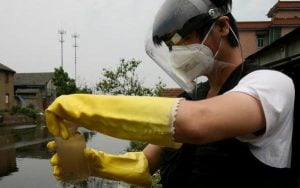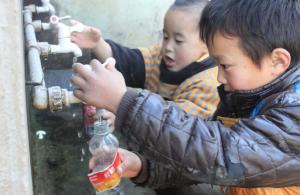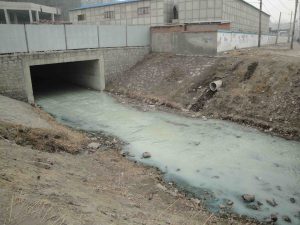In 2011, China launched a huge policy and investment drive to bring safe drinking water to the entire country, including its remotest areas. The central government’s goals included “completely solving rural drinking water safety issues,” a target enshrined in the 12th Five Year Plan (2011-2015).
When Premier Li Keqiang visited the Ministry of Water Resources (MWR) in late 2014 to review progress, he described the remaining tasks as “hard bones” to chew. His first stop on that November 24 visit was the Rural Water Division to check on rural drinking water safety projects and plans.
While city dwellers have mainly demanded better water quality, the drinking water safety issues facing rural Chinese are arguably even more urgent. Some face problems obtaining water at all, while more struggle to get enough enough clean, accessible and affordable drinking water.
Targets and spending
So what were the goals set out in the nationwide “12FYP Rural Safe Drinking Water Project?” They included access to safe drinking water for 298 million rural residents, and for teachers and students in 114,000 rural schools by end-2015, and raising the centralized water supply rate to 80%.
Investment in rural drinking water safety-related infrastructure construction during the 12FYP was set at 175 billion yuan (US$47.88 billion). Although this may seem relatively low compared with 410 billion yuan for urban water supply, it is still the largest investment in rural drinking water in recent years.
Investment during the 12FYP built on past initiatives. The Ministry of Health (MoH) launched a nation-wide “rural water supply improvement” project in 1990. Since 2000, the central government has invested almost 300 billion yuan in rural drinking water safety projects. During the 11th Five Year Plan period (2006-2010), the topic was promoted to a national planning level problem. Three major government bodies — the National Development and Reformation Commission (NDRC), MWR and Ministry of Environmental Protection (MEP) — jointly released the first "National Rural Drinking Water Safety Project" five-year plan, which received 100.9 billion yuan in government funds, and led to safer drinking water safety for over 210 million rural residents.
Contingency projects have brought “life-saving water” to rural people who either lacked water or didn’t have drinkable water. But the challenges ahead remain substantial.
At the end of 2010 when the 12FYP began, there were still over 400 million rural Chinese – 42% of the rural population — who had to collect water directly from water sources, using basic water supply delivery systems, or none. Among them, 85.72 million people had no water supply facilities at all, and so were getting their water directly from rivers, streams and ponds.
Of the 298 million rural residents whose drinking water safety problems were meant to be addressed during the 12FYP, 105 million people had water of substandard quality, and 91.3 million faced water shortages.
Not all these problems have been solved. At the beginning of 2015, 51.63 million rural residents and 7.04 million rural teachers and students still had unresolved drinking water issues, according to the MWR.
As the 12FYP enters its deadline year, it is clear that China still faces many challenges in order to meet its rural drinking water safety goals.
Big challenges ahead
One worry is that in the quest to achieve the central government’s goal of “completely solving” rural water problems by 2015, construction of supply systems will be completed in a hurry but water supply and quality may not be guaranteed, according to a staff member involved in the mid-term evaluation of the “National Rural Drinking Water Safety Project 12FYP,” who revealed that a group of experts had submitted an assessment of early achievements and problems with the projects in the first half of the 12FYP.
Liu Wenjun, director of the Division of Drinking Water Safety at Tsinghua University, commented that, “completely solving” rural drinking water problems would involve more of an administrative planning style than the current approach. He added that completely solving the issue for everyone is a “mission impossible.”
As rural drinking water is a complex issue, Liu worries that there will always be people who are missed out, usually those living in remote areas with no, or only poor quality, water supply due to geographical limitations. Moreover, economic constraints make it extremely difficult to solve drinking water issues for these people.
The ‘A Glass of Clean Water’ project by NGO Greenovation Hub surveyed nearly 100 villages and six schools across 11 provinces in China. The survey found that local governments have favored large-scale, low-cost rural drinking water construction projects with larger numbers of beneficiaries in an effort to achieve central government goals. As a result, small-scale projects and those in remote areas have lagged behind.
Rural drinking water safety faces great challenges to water resources, in terms of both quantity and quality. On one hand, lower overall availability of water to due climate change and overuse of groundwater has led to significant reduction or depletion of groundwater and surface water sources in certain rural areas. The result: some villagers who were helped by previous projects once again lack safe drinking water. Meanwhile, the quality of rural drinking water sources has deteriorated under the impact of mining, industrial wastewater discharge, excessive pesticide and fertilizer use, livestock breeding, domestic sewage discharge, and improper waste disposal.
Going backwards?
The quality of drinking water in rural China also needs urgent attention. At present, rural drinking water is regulated by a “less stringent” version of the "National Drinking Water Quality Standard", and some indicators are relaxed. Whether rural drinking water meets even this standard remains unclear. Official channels rarely disclose information. Rural drinking water crises are widely reported by media around the country.
As 2015 progresses goals are being devised for the 13FYP (2016-2020). Water Resources minister Chen Lei, said in January that the 13FYP would include work on improving rural drinking water quality and the efficiency of water supplies. Steps will be taken to increase rural tap water penetration rate, water supply guarantee rate and water quality levels, he said.
“China’s Long March To Safe Drinking Water,” a joint report being released by China Water Risk and chinadialogue identifies further key issues threating rural drinking water safety. They include unclear water price mechanisms; a lack of sustainable projects; lack of human resources; and securing funding for existing and future projects. Rural drinking water safety is “heavy on construction” and “light on management”, the report says.







